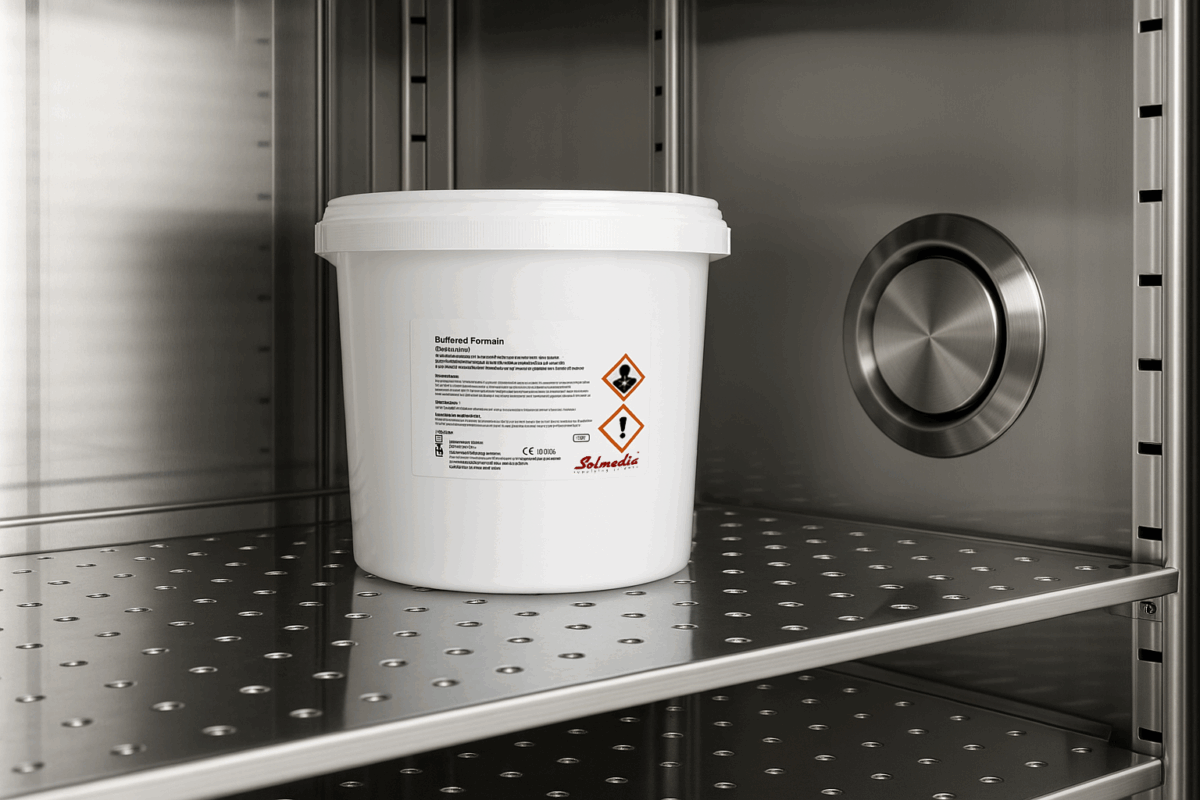Reduce spill, splash and exposure risks from formalin/formaldehyde in pathology and histology labs by adopting a simple, evidence-based rule: store large or breakable formalin containers below shoulder (eye) height. This briefing explains why the rule matters, links to UK guidance, and practical controls — including Solmedia product suggestions — that make compliance simple and effective.
Why this matters
- Safety first: Lifting heavy or fragile containers overhead increases the risk of dropping, shattering and exposing staff to harmful vapours and liquid formalin. Even small spills can cause inhalation, skin or eye irritation and may require incident response and downtime.
- Regulatory alignment: HSE guidance (e.g. Health and Safety in Laboratories / COSHH principles) recommends storing heavy or breakable chemical containers below shoulder height and using stable shelving and secondary containment. Following this reduces the likelihood of reportable incidents and supports compliance.
- Operational impact: Spills cause immediate disruption (clean-up, staff exposure assessment, possible lab closure), reputational risk and cost (clean-up, replacement, lost productivity). Preventing spills protects staff and preserves lab throughput.
One article found that improper storage of chemicals accounts for nearly 25% of all lab accidents.( Today’s Clinical Lab)
Lab safety guidelines from multiple sources recommend not storing heavy/large chemical containers above ~1.5 m (≈ 5ft) above floor to reduce the risk of accidents such as falls or spills.
Recognised Laboratory Safety Guidelines
That recommendation — not to store heavy or large chemical containers above approximately 1.5 m (≈ 5 ft) — is supported by several recognised laboratory safety authorities and standards organisations. Here are the main sources and where this guidance comes from:
Guidelines
- Document: Health and Safety in Laboratories (HSG118) and Control of Substances Hazardous to Health Regulations (COSHH).
- Guideline Summary:
The HSE advises that chemicals and reagents should be stored below shoulder height whenever possible to prevent spills, splashes, or dropped containers.
“Heavy or breakable containers should be stored below shoulder height to avoid injury or chemical exposure if they fall.”
Reference: HSE Laboratory Safety Guidance (HSG118)
- Guideline Summary:
The WHO recommends that volatile or hazardous chemicals be stored “on lower shelves or in secured cabinets” to reduce spill and exposure risk.
“Avoid placing chemicals on shelves above eye level; use stable shelving and secondary containment.”
Reference: WHO Laboratory Biosafety Manual, 4th Edition
- Guideline Summary:
“Do not store chemicals or breakable containers above eye level. Heavy items should be stored as close to floor level as practical.”
Reference: BMBL, 6th Edition (CDC/NIH)
- Guideline Summary:
“Avoid storing large containers of chemicals above shoulder height. Shelving should be secured and equipped with lips or barriers to prevent falling.”
Reference: Prudent Practices in the Laboratory: Handling and Management of Chemical Hazards

